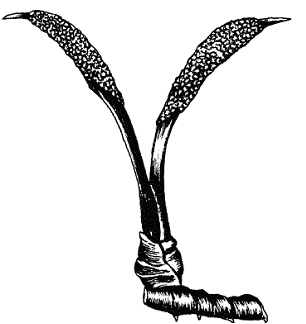
SPECIALIZING IN MARKETING, PROCESSING, AND COTTAGE INDUSTRIES
1212 SW 5th Street
Grants Pass, OR 97526-6104
(541) 476-5588
(541) 476-1823 (FAX)
 |
Northwest
Botanicals,Inc. SPECIALIZING IN MARKETING, PROCESSING, AND COTTAGE INDUSTRIES |
1212 SW 5th Street
Grants Pass, OR 97526-6104
(541) 476-5588
(541) 476-1823 (FAX)
|
See
Our Price Lists: Shelf
Ready Products and Mycelium
Powders in Bulk
For Further Studies See: Studies
with CORDYCEPS sinensis,
The Hybridization Of Cordyceps Sinensis Strains
HISTORY AND TRADITIONAL USES Traditionally, the powdered fungus is mixed with other tonic herbal medicines such as ginseng, or it may be boiled and taken as a tea or soaked in alcohol for a tincture. It is mainly used to treat low energy following serious illness and as a strengthening tonic. Other traditional uses include the treatment of cough, anemia, tuberculosis, lower back pain (Pegler et al., 1994), impotence, infertility, irregular menstruation, night sweats, and senile weakness. It continues
to be used as a tranquilizer or sedative in traditional Chinese medicine
(TCM) (Ying et al., 1987; Liu and Bau, 1980; Guo, 1986), although compared
to Western drug standards these effects are inherently mild. Cordyceps
is also taken in TCM to keep the lungs fit, strengthen the kidneys, build
up the bone marrow, reduce phlegm, and stop hemorrhages (Ying et al.,
1987; Liu and Bau, 1980). |
 |

CHEMISTRY
|
Carbohydrates Polysaccharides Polysaccharides in Cordyceps have shown various activities: hypoglycemic (CS-F30) (Kiho et al., 1996); hypolipidemic (CS-F30) (Kiho et al., 1996); immunostimulating (CS-81002) (Gong et al., 1990) immunostimulating/radioprotective/antitumor (polysaccharide I) (Zang et al., 1985); and antileukemic (polysaccharide fraction-conditioned medium) (Chen et al., 1997). Nitrogenous
Compounds Other Constituents Cordyceps
sinensis also contains: galactomannans (Miyazaki et al., 1977; Kiho
et al., 1986), polyamines (spermine, spermidine, homospermidine, putrescine,
1,3-diaminopropane) (Zhu and Masaru, 1993), various uncommon cyclic dipeptides,
minerals, vitamins B1, B2, B12, E and K, all the essential amino acids
(Yue et al., 1995; Huang et al., 1991; Xu et al., 1992; Guo, 1986; Tao,
1995; Xia et al., 1985), glutamic acid, Ltryptophan, L-arginine, and lysine
(Zhang et al., 1991). C. sinensis also contains d-mannitol, ergosterol,
ergosterol derivatives, alkaloids, fatty acids (mainly oleic, linoleic,
palmitic, and stearic acids) (Shiao et al., 1989), and sterols (Kadota
et al., 1986). |
 |
THERAPEUTIC APPLICATIONS
|
|
SAFETY PROFILE Toxicity in Animal Models Strain Cs-B414 produced an LD50 in mice of 27.26±4.38 g/kg i.p. The p.o. tolerance dose was 252.5-300 g/kg. No significant hematological toxicity was found in rabbits administered Cs-B414 at a dosage of 10 g/kg/day p.o. for 3 months. Neither kidney, liver, nor major organs showed significant toxicity compared to placebo-fed rabbits (Huang et al., 1987). A 3-month, placebo-controlled, subacute toxicity study in both sexes of rats found the Cs-4 strain caused no toxicity or deaths at a dosage of 3 g/kg p.o. A 30-day, placebo-controlled toxicity study in mice found no signs of toxicity and no deaths from Cs-4. In both studies, organ weights and peripheral blood cells were not significantly different from those of the controls (Zhu et al., 1998a). KEY REFERENCE Institute for Natural Products Research Cordyceps Monograph |
Research and clinical studies have shown Cordyceps Sinensis to be completely safe when recommended dosage levels are followed.
Research and clinical studies are available upon request.
For further information, call, fax, or visit our web site.
541-476-5588
541-476-1823
(fax)
(541) 218-8111
(cell)
The FDA has not evaluated these statements.
This product is not intended to diagnose, treat, cure or prevent disease.
Page Update: 02-06-04